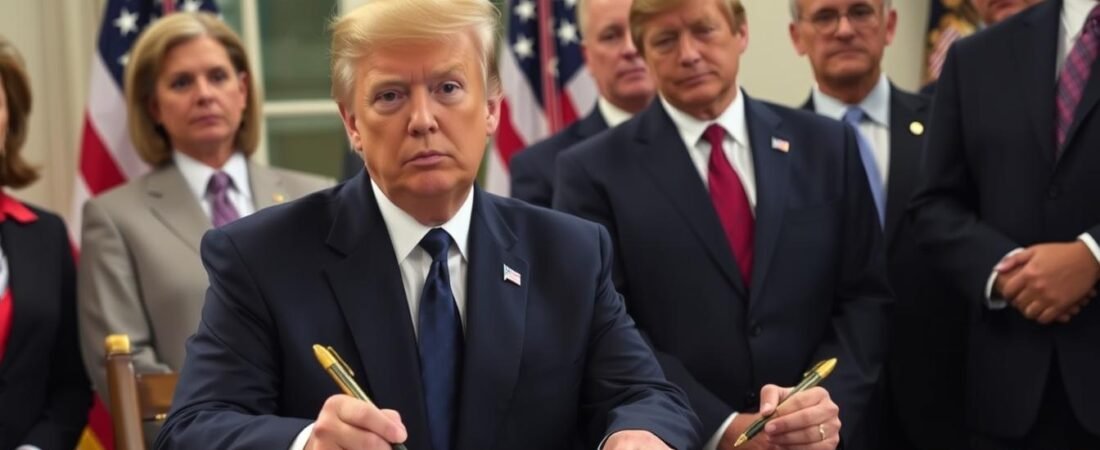President Donald Trump’s self-proclaimed “Big Beautiful Bill” represents the most sweeping domestic policy achievement of his second term. With permanent tax cuts, significant changes to social programs, and a reshaping of America’s energy policy, this legislation will impact virtually every American household. But beyond its immediate policy implications lies a crucial political question: Will this bill serve as Trump’s winning card in the 2026 midterm elections?
As Democrats and Republicans prepare their messaging strategies for the coming electoral battles, understanding this bill’s provisions and potential impacts becomes essential for voters and political observers alike. This analysis explores how the “Big Beautiful Bill” might shape America’s political landscape in the years ahead.
The “Big Beautiful Bill”: Key Provisions and Political Strategy
The House passed Trump’s massive spending and tax bill in July 2025 by a narrow margin of 218 to 214, with the Senate approving it 51-50 after Vice President JD Vance cast the tie-breaking vote. This legislative achievement represents a significant political victory for Trump, demonstrating his continued dominance over the Republican Party.
At its core, the bill makes permanent most of Trump’s 2017 Tax Cuts and Jobs Act provisions that were set to expire, while adding new tax breaks and implementing substantial cuts to social safety net programs. The Congressional Budget Office estimates it will add $3.4 trillion to federal deficits over the next decade.
Core Components of the Bill
- Permanent extension of 2017 tax cuts
- Increased child tax credit from $2,000 to $2,200
- Tax deductions for tip income and overtime pay
- Increased SALT deduction cap from $10,000 to $40,000
- $5 trillion increase to the debt ceiling
- Medicaid work requirements and eligibility restrictions
- Cuts to SNAP (food stamp) benefits
- Elimination of clean energy tax credits
- $46.5 billion for border wall construction
- “Trump accounts” with $1,000 federal deposit for children
Trump hailed the bill as “the greatest victory yet” and “the most popular bill ever signed in the history of our country” during the July 4th signing ceremony. However, a June 2025 Quinnipiac poll found only 29% of voters supported the bill, while 55% opposed it.
Tax Provisions: Winners and Losers
The centerpiece of the Big Beautiful Bill is the permanent extension of Trump’s 2017 tax cuts, which were scheduled to expire after 2025. These extensions primarily benefit middle and upper-income Americans, while new provisions create additional tax advantages for specific groups.
Key Tax Changes
| Provision | Details | Political Impact |
| Standard Deduction | Increased from $15,000 to $15,750 (single) and $30,000 to $31,500 (married) | Broadly popular across income levels |
| SALT Deduction | Cap raised from $10,000 to $40,000 through 2029 | Appeals to voters in high-tax blue states |
| Tip Income | Up to $25,000 deduction for service workers | Targets working-class service industry voters |
| Overtime Pay | Up to $12,500 deduction ($25,000 for married couples) | Appeals to blue-collar workers in swing states |
| Senior “Bonus” | $6,000 deduction for Americans 65+ (through 2028) | Targets reliable older voters |
The tax provisions reflect a clear political strategy of targeting key voter demographics that could be decisive in the 2026 midterms. Service workers, blue-collar employees working overtime, and seniors all represent crucial voting blocs in swing states.

However, critics argue that the permanent tax cuts disproportionately benefit wealthier Americans while adding significantly to the national debt. The increased SALT deduction cap, while appealing to voters in high-tax states like New York, California, and New Jersey, primarily benefits upper-middle-class and wealthy homeowners in these areas.
Energy Policy Shifts: Battleground State Implications
The Big Beautiful Bill makes dramatic changes to America’s energy policy by eliminating tax credits for clean energy, electric vehicles, and energy efficiency programs that were established or enhanced by the 2022 Inflation Reduction Act.
Key Energy Policy Changes
- Elimination of $7,500 tax credit for new electric vehicles
- Termination of $4,000 tax credit for used EVs
- Removal of tax breaks for home energy efficiency improvements
- End of incentives for rooftop solar and electric heat pumps
- Termination of the Greenhouse Gas Reduction Fund
These changes represent a significant shift in federal energy policy, moving away from incentives for renewable energy and electrification toward traditional fossil fuel production. The political implications of these changes vary significantly by region and could be decisive in several battleground states.
Regional Political Impacts
Rust Belt States
Michigan, Pennsylvania, and Ohio could see mixed reactions. Traditional auto manufacturing benefits from reduced EV pressure, but growing clean energy manufacturing sectors may suffer.
Sun Belt States
Arizona, Nevada, and Georgia have growing solar industries that could be negatively impacted, potentially creating political vulnerabilities in these swing states.
Energy-Producing States
Texas, Pennsylvania, and New Mexico may see economic benefits in traditional energy sectors, reinforcing Republican support in these areas.
The energy provisions create clear contrasts between Republican and Democratic policy visions, setting up energy policy as a key battleground for the 2026 midterm campaigns. Democrats are likely to highlight job losses in clean energy sectors, while Republicans will emphasize lower energy costs and energy independence.
Historical Comparison: Major Bills and Midterm Consequences
To understand how the Big Beautiful Bill might impact the 2026 midterms, it’s instructive to examine how other major legislative achievements have affected subsequent elections.
| Legislation | Administration | Key Provisions | Midterm Result |
| Reagan Tax Cuts (1981) | Reagan | 23% reduction in individual tax rates | Lost 26 House seats in 1982 |
| Bush Tax Cuts (2001) | G.W. Bush | Reduced income tax rates, increased child credit | Gained 8 House seats in 2002 |
| Affordable Care Act (2010) | Obama | Health insurance expansion, regulations | Lost 63 House seats in 2010 |
| Tax Cuts & Jobs Act (2017) | Trump | Corporate and individual tax cuts | Lost 40 House seats in 2018 |
| Inflation Reduction Act (2022) | Biden | Climate investments, healthcare provisions | Lost 9 House seats in 2022 |
The historical pattern suggests that major legislative achievements often lead to midterm losses for the president’s party. However, the specific provisions of the Big Beautiful Bill target key voter demographics in ways that previous legislation did not, potentially mitigating some of these traditional midterm headwinds.
Unlike the Affordable Care Act or the original Tax Cuts and Jobs Act, the Big Beautiful Bill includes direct benefits for working-class voters (tip and overtime deductions), seniors (bonus deduction), and homeowners in high-tax states (SALT cap increase) – all key voting blocs in midterm elections.
Expert Perspectives: Will the Bill Help or Hurt in 2026?
“Trump’s control over the GOP is as close to total as any President has ever had over his own political party. The passage of the Big Beautiful Bill demonstrates that Republicans are willing to follow his lead even on politically risky policies.”
Republican Perspective
Republican strategists argue that the bill’s tax provisions create tangible benefits that voters will feel before the 2026 midterms. The targeted nature of many provisions – specifically aimed at service workers, overtime earners, and seniors – could help Republicans maintain support among key demographics that might otherwise drift toward Democrats.
Additionally, the bill’s border security funding and immigration provisions appeal to the Republican base, potentially driving turnout in a midterm election where base enthusiasm is crucial.
Democratic Perspective
Democratic analysts point to the bill’s cuts to Medicaid and food assistance as politically vulnerable aspects that could mobilize opposition. With millions of Americans potentially losing benefits, Democrats see opportunities to frame the bill as harmful to working families while primarily benefiting the wealthy.
“The Big Beautiful Bill gives Democrats a clear message for 2026: Republicans cut healthcare and food assistance for millions of Americans to fund tax cuts that primarily benefit the wealthy. This bill will be an albatross around Republican candidates’ necks.”
Economic Analysis
Economic experts are divided on the bill’s long-term impacts. Some point to potential growth stimulation from the tax cuts, while others warn about the substantial addition to the national debt and potential inflationary pressures.
The bill’s actual economic performance by 2026 will likely be a significant factor in how voters perceive it during the midterm elections. If economic growth accelerates and inflation remains controlled, Republicans could benefit. If deficits balloon or growth stagnates, Democrats will have powerful ammunition.
Voter Impact: Who Wins and Loses?
The political impact of the Big Beautiful Bill will ultimately depend on how different voter groups experience its effects. Some provisions create clear winners, while others establish groups that may feel negatively impacted by the legislation.
Potential Winners
- Service industry workers: Benefit from tip income tax deduction
- Overtime workers: Receive new tax deduction for overtime earnings
- Seniors: Gain $6,000 tax deduction through 2028
- Homeowners in high-tax states: Benefit from increased SALT deduction cap
- Parents: Receive slightly higher child tax credit
- Small business owners: Permanent extension of pass-through business deduction

Potential Losers
- Medicaid recipients: 11.8 million may lose coverage under new restrictions
- SNAP beneficiaries: 5.3 million families facing benefit reductions
- Clean energy workers: Job losses from eliminated tax credits and incentives
- Electric vehicle industry: Reduced demand from eliminated tax credits
- Future generations: Increased national debt burden
The geographic distribution of these impacts could be crucial for the 2026 midterms. Swing states like Pennsylvania, Michigan, Wisconsin, Georgia, and Arizona contain significant populations of both potential winners and losers under the bill, creating complex political dynamics.
Battleground State Analysis: 2026 Implications
The Big Beautiful Bill’s provisions will have varying impacts across key battleground states that will determine control of Congress in 2026. Understanding these state-specific effects provides insight into potential electoral outcomes.
Pennsylvania
Winners: Manufacturing workers (overtime deduction), seniors (bonus deduction)
Losers: 420,000 Medicaid recipients at risk, clean energy sector workers
Political Impact: Mixed, with rural areas benefiting more than urban centers
Michigan
Winners: Auto industry workers (overtime deduction), homeowners (SALT)
Losers: Growing EV manufacturing sector, 380,000 SNAP recipients
Political Impact: Potentially negative in Detroit metro, positive in rural areas
Georgia
Winners: Service industry workers (tip deduction), parents (child tax credit)
Losers: 310,000 Medicaid recipients at risk, growing solar industry
Political Impact: Could exacerbate urban/rural divide
The bill’s impacts in these battleground states create both opportunities and challenges for Republicans in 2026. While tax benefits may appeal to working-class voters who have been drifting toward Republicans, the social program cuts could energize Democratic turnout in urban areas.
The timing of the bill’s implementation is also significant. Most tax benefits take effect immediately, while some of the more controversial program cuts are phased in over time. This timing could allow Republicans to highlight benefits before the full impact of cuts is felt.
Campaign Messaging: How Both Parties Will Frame the Bill
As the 2026 midterm elections approach, both Republicans and Democrats will develop messaging strategies around the Big Beautiful Bill. These narratives will shape how voters perceive the legislation and its impact on their lives.
Republican Messaging Strategy
Republicans are likely to emphasize the tangible benefits of the bill, particularly the tax provisions that directly impact voters’ wallets. Key messaging points will include:
- Tax relief for working Americans through tip and overtime deductions
- Support for seniors through the “bonus” deduction
- Enhanced child tax credit for families
- Border security funding to address immigration concerns
- Fiscal responsibility through program reforms
Democratic Messaging Strategy
Democrats will likely focus on the bill’s cuts to social programs and its impact on vulnerable populations. Their messaging will emphasize:
- Medicaid cuts affecting millions of Americans
- Reduced food assistance for families in need
- Tax benefits skewed toward wealthier Americans
- Increased national debt burden for future generations
- Elimination of clean energy incentives and climate impacts
The effectiveness of these competing narratives will depend on economic conditions in 2026, how voters experience the bill’s provisions, and which party better connects their message to voters’ lived experiences.
Conclusion: A Political Gamble with Uncertain Payoff
The Big Beautiful Bill represents a significant political gamble for President Trump and congressional Republicans. By implementing sweeping tax changes and program reforms, they’ve created clear policy contrasts with Democrats heading into the 2026 midterms.
Historical patterns suggest that major legislative achievements often lead to midterm losses for the president’s party. However, the targeted nature of many provisions in this bill – specifically designed to benefit key voting demographics – could potentially disrupt this pattern.
The ultimate political impact will depend on several factors:
- Economic performance between now and 2026
- How effectively benefits are delivered to target populations
- The visibility and impact of program cuts
- Which party better frames the narrative around the bill
- Other intervening political events that may overshadow the bill
What’s clear is that the Big Beautiful Bill will be a central focus of political debate heading into 2026. Whether it proves to be Trump’s winning card or a political liability remains to be seen, but it has undoubtedly reshaped America’s policy landscape and set the stage for the next major electoral contest.
Frequently Asked Questions
How does Trump’s Big Beautiful Bill differ from his 2017 tax cuts?
While the 2017 Tax Cuts and Jobs Act focused primarily on corporate tax cuts and temporary individual tax reductions, the Big Beautiful Bill makes those individual cuts permanent while adding new targeted deductions for specific groups like service workers and seniors. It also includes significant social program reforms and border security funding not present in the 2017 legislation.
Which states benefit most from the bill?
The bill’s impact varies significantly by state. High-tax states like New York, New Jersey, and California benefit from the increased SALT deduction cap. States with large service industries like Nevada and Florida benefit from the tip income deduction. Meanwhile, states with high Medicaid enrollment may see negative impacts from program restrictions.
How will the bill affect the national debt?
The Congressional Budget Office estimates the bill will add approximately .4 trillion to federal deficits over the next decade. This increase occurs despite the significant cuts to social programs, as the tax reductions and new deductions reduce federal revenue more than the spending cuts save.
When will Americans start feeling the bill’s effects?
Many tax provisions take effect immediately for the 2025 tax year, meaning taxpayers will see benefits when filing their taxes in early 2026. Program changes like Medicaid work requirements are phased in more gradually, with full implementation not occurring until late 2026 or 2027 in many cases.
Could Democrats repeal the bill if they win in 2026?
A Democratic sweep in 2026 could potentially lead to modifications of the bill, but full repeal would be challenging. The popular tax provisions would be difficult to roll back without political consequences. More likely, Democrats would seek to restore funding to social programs while maintaining many of the tax benefits, particularly those aimed at middle and working-class Americans.
Stay Informed on 2026 Election Developments
Get expert analysis on how Trump’s Big Beautiful Bill will impact the political landscape leading up to the crucial 2026 midterms.
How Will the Bill Affect Your Taxes?
Download our comprehensive guide to understanding how the Big Beautiful Bill’s tax provisions will impact your personal finances.
Voice Your Opinion
Will Trump’s Big Beautiful Bill help or hurt Republicans in the 2026 midterms? Participate in our reader poll and see how others are voting.
State-by-State Impact Analysis
Download our detailed report on how the Big Beautiful Bill affects each state’s economy, tax burden, and social programs.
Stay Informed on 2026 Election Developments
Subscribe to our political analysis newsletter for ongoing coverage of how Trump’s Big Beautiful Bill is shaping the political landscape.

Social Program Cuts: Political Risks and Rewards
The Big Beautiful Bill implements significant cuts to social safety net programs, most notably Medicaid and SNAP (food stamps). These cuts represent the most politically risky aspects of the legislation, as they directly impact millions of Americans, including many in key swing states.
Medicaid Restrictions
The bill cuts approximately $1 trillion from Medicaid over the next decade through work requirements, more frequent eligibility checks, and limits on provider taxes. The Congressional Budget Office estimates that 11.8 million Americans could lose health coverage under these provisions.
To mitigate potential backlash, especially in rural areas where hospital closures could result from funding cuts, the bill includes a $50 billion rural hospital stabilization fund. This targeted approach aims to protect Republican support in rural communities while still achieving overall spending reductions.
SNAP Benefit Changes
The legislation expands work requirements for food stamp recipients to include adults ages 55 to 64 and parents with children 14 and older. It also shifts some program costs to states with higher error rates in benefit distribution.
According to the Urban Institute, approximately 5.3 million families could lose at least $25 in monthly SNAP benefits, with an average reduction of $146 per month. These cuts disproportionately affect lower-income Americans, including about 16 million children, 8 million seniors, and 4 million non-elderly adults with disabilities.
Political Advantages
Political Risks